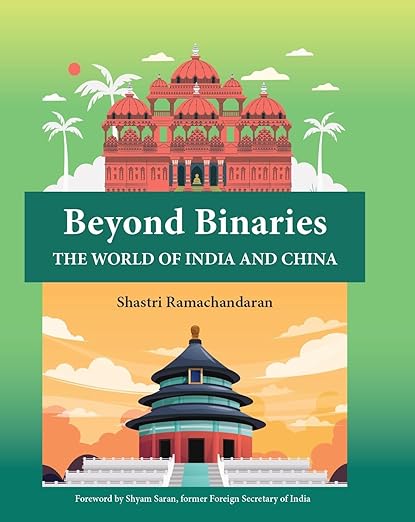Book Summary by Ms. Chaitra Apte, Research Intern, PIC
Beyond Binaries explores the various intricacies of India-China relations with respect to their history, geopolitical landscape, economic factors, other external factors, and more.
It gives a detailed overview of the situation from both the Indian and the Chinese perspectives. In the Foreword, Shyam Saran, former Foreign Secretary of India, points out that India and China being two of the world’s largest economies, the evolution of their relationship over the coming years is important not only for the two countries but also for the rest of the world.
Beyond Binaries is a compilation of writings by the author, Shastri Ramachandaran, from 2008 to 2022. In the book, he draws from his experiences as a veteran journalist who has written on national and global affairs with focus on Nepal, Sri Lanka and China and has also worked for publications in both India and China, as well as Europe.
The book is in four parts – Introduction, India-China Relations, The World of India and China, and Manufacturing Mindsets.
The Introduction outlines various aspects of China’s socio-political landscape, divided into four subsections: Society, Politics, Economy, and Media/Cybersecurity. In the Society section, the author discusses the evolution of transportation, healthcare, and the controversial one-child policy. The Politics section highlights China’s economic boom from 2000-2010, its internal challenges, and the secretive nature of the Communist Party. The Economy section focuses on President Xi Jinping’s Belt and Road Initiative (BRI) and China’s transition from an export-driven to a more diverse economy. Lastly, the Media and Cybersecurity section touches upon China’s legislative measures to safeguard sovereignty, and the controversy surrounding it. The Introduction sets the stage for a deeper exploration into China’s evolving role on the global stage and its complex relationships with other nations.
The chapter India-China Relations provides a comprehensive overview of the historical context, current challenges, and potential areas for cooperation and conflict between the two nations. Part 1 of the chapter outlines the evolution of India-China relations, highlighting past agreements and periods of cooperation, particularly in trade relations under leaders like Manmohan Singh. However, it also notes the persisting border dispute and recent tensions, culminating in the Galwan clashes in 2020. Part 2 looks at the complexities of cooperation and conflict, emphasising the significance of the boundary dispute and regional dynamics, such as the issue of Tibet and the construction of dams in the region. It also discusses incidents like the Ladakh incursion and the Doklam standoff, underlining the need for strategic maturity in managing differences. The chapter underscores the multifaceted nature of India-China relations and suggests that while challenges exist, both countries have opportunities to collaborate on issues like poverty alleviation and economic development.
The chapter The World of India and China gives insights into the broader implications of the relationship between the two Asian giants and their global engagements. Part 1 of the chapter highlights the geopolitical significance of India and China within regional and international frameworks. It discusses China’s observer status at SAARC and its interest in becoming a member, contrasting with India’s position as a member. Additionally, it explores initiatives like BRICS, aimed at reshaping the global monetary system, and the contentious Belt and Road Initiative, including its impact on India and the region. The chapter also examines the intricate relationships between India, China, and other neighbouring countries, shedding light on their influence on bilateral ties.
Part 2 focuses on China’s role on the global stage, particularly in relation to the US. It discusses the global ramifications of China’s actions, including its response to the Covid-19 pandemic and its influence on countries like Australia, Russia, and Ukraine. Overall, the chapter provides valuable insights into the complex interactions between India and China within the broader geopolitical landscape, highlighting both opportunities for cooperation and areas of contention.
The chapter Manufacturing Mindsets delves into the portrayal of India-China relations in the media of both nations and the role of the media, state, and think tanks in shaping public perception. In Part 1, the focus is on the portrayal of China in the Indian media, highlighting an often negative and sensationalised narrative. It raises questions about the accuracy and fairness of media coverage, noting China’s status as a rising global power and the implications of its economic ascent. The author suggests that Indian media may not accurately depict India’s relations with its neighbours, hinting at biases or shortcomings in reporting. Part 2 explores the role of the Chinese media, state, and think tanks in shaping public discourse and perceptions of India-China relations. It underscores the interconnectedness of think tanks and media in China and draws comparisons between media management in India and China throughout history. The chapter raises important questions about the accuracy, objectivity, and potential biases in media coverage of international affairs.
In summary, through a comprehensive examination of diverse themes spanning politics, economics, and media, the book underscores the intricate dynamics and challenges within India-China relations. While highlighting opportunities for cooperation, it emphasises the imperative of nuanced understanding and strategic engagement to navigate the complexities and foster mutual prosperity.

